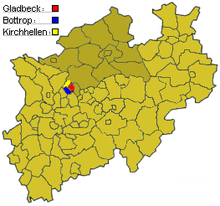Glabotki
As part of the municipal reorganization in the Ruhr area , the city of Gladbeck , which was independent from January 1, 1921 , became the new with effect from January 1, 1975 with the city of Bottrop, which was also independent from January 1, 1921, and the municipality of Kirchhellen , which belonged to the Recklinghausen district City of Bottrop united. Colloquially, this structure was called " Glabotki ".
The story of Glabotki 1975/1976
The city of Gladbeck sued the merger and achieved a correction of the territorial reform. With effect from December 6, 1975, Gladbeck and Kirchhellen left the city of Bottrop and became independent again. The so-called St. Nicholas judgment of December 6, 1975, which the Constitutional Court for the State of North Rhine-Westphalia - Az. 13/74 - had passed, stated that the reorganization did not provide any closeness to the citizen or higher administrative efficiency. This was the reason for the reorganization.
With effect from July 1, 1976, Gladbeck was finally attached to the Recklinghausen district as a district town .
Kirchhellen came to terms with the situation and on July 1, 1976 it became a district of Bottrop again. The division and incorporation into Gelsenkirchen (north of the community together with Gladbeck) and Essen or Oberhausen (south of the community together with Bottrop) were avoided.
backgrounds
Territorial reform
The regional reform in North Rhine-Westphalia in 1975 initially made 369 of the 2297 municipalities that existed on April 1, 1967, and 31 out of 57 districts, and the number of urban districts was reduced from 37 to 23. The aim of the reform was to be more successful administratively in order to be able to provide better economic impetus. After the Correction Act of 1976, Gladbeck , Meerbusch , Monheim and Wesseling were restored as independent municipalities, thus increasing the number of municipalities belonging to the district to 373.
In 1975, the city of “Glabotki” would have had 200,700 inhabitants, which would have complied with the requirements of the legislature to only allow urban districts with at least 200,000 inhabitants in the Ruhr area. After Gladbeck was spun off, the new town of Bottrop with Kirchhellen only had 116,043 inhabitants.
Local politics
Initially, Johann Wuwer was the representative for the tasks of the council of the newly formed city. In the local elections in 1975 the SPD was again the strongest force, and Theo Knorr prevailed in the internal power struggle against incumbent Ernst Wilczok for the candidacy for mayor with 116 to 106 votes. He was elected in the newly elected council with 32 to 27 votes.
Similar cases
- Lahn , a short-lived (1977–1979) city in Hesse
literature
- Erna-Johanna Fiebig, Rainer Weichelt: Glabotki is not! On the history of the municipal reorganization in the Ruhr area using the example of the Gladbeck / Bottrop / Kirchhellen area . Klartext-Verlag, Essen 1989. ISBN 3-88474-341-4 .
Individual evidence
- ↑ a b c d Federal Statistical Office (Hrsg.): Historical municipality register for the Federal Republic of Germany. Name, border and key number changes in municipalities, counties and administrative districts from May 27, 1970 to December 31, 1982 . W. Kohlhammer, Stuttgart / Mainz 1983, ISBN 3-17-003263-1 , p. 311 .
- ↑ The show of strength. Local regional reform in North Rhine-Westphalia . Düsseldorf, 2005 (Writings of the State Parliament of North Rhine-Westphalia; Vol. 16), p. 149
- ↑ Martin Bünermann, Heinz Köstering: The communities and districts after the municipal territorial reform in North Rhine-Westphalia . Deutscher Gemeindeverlag, Cologne 1975, ISBN 3-555-30092-X , p. 12 .
- ↑ The show of strength. Local regional reform in North Rhine-Westphalia . Düsseldorf, 2005 (Writings of the State Parliament of North Rhine-Westphalia; Vol. 16), p. 191
Web links
Coordinates: 51 ° 31 ' N , 6 ° 55' E
